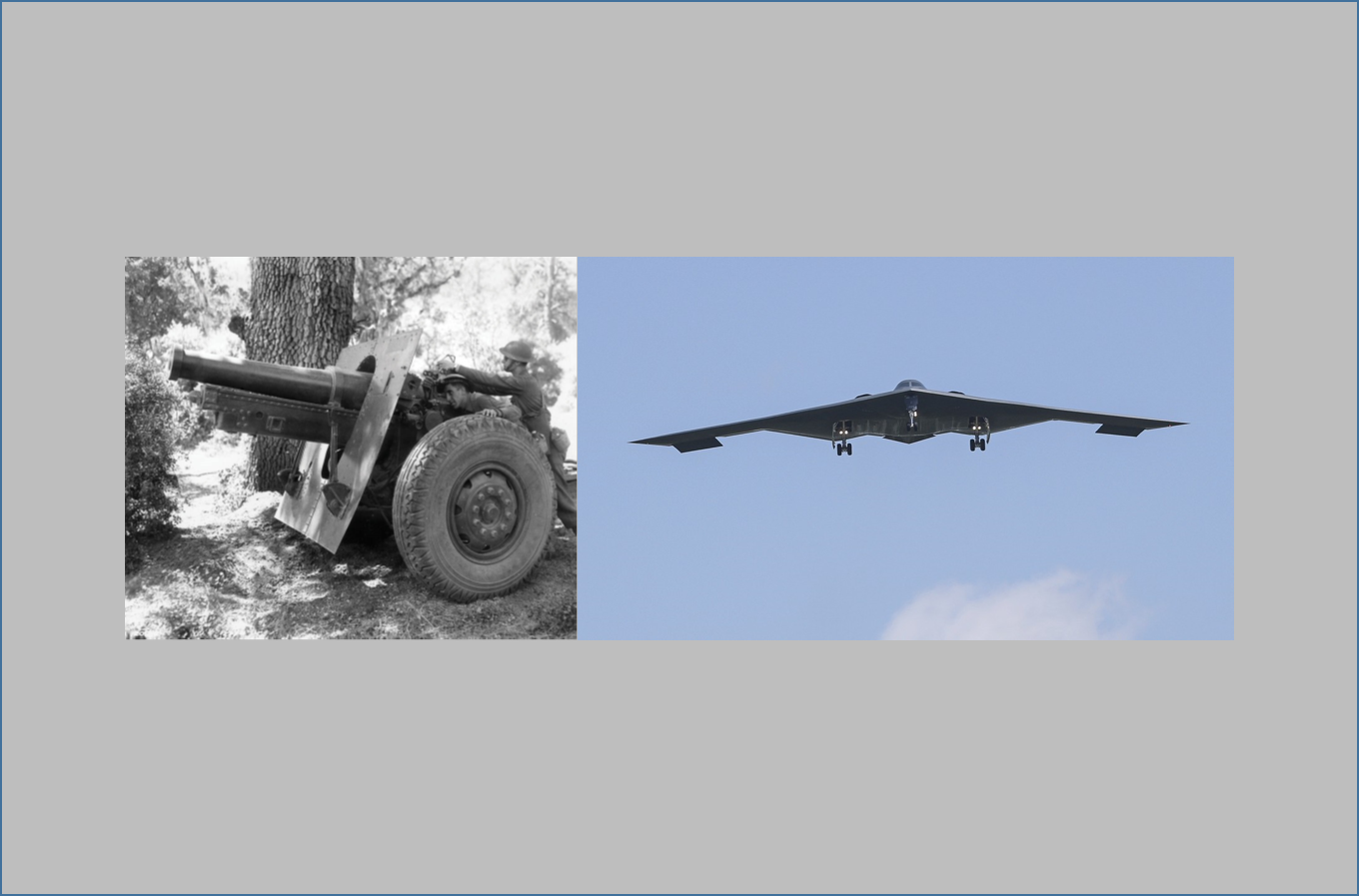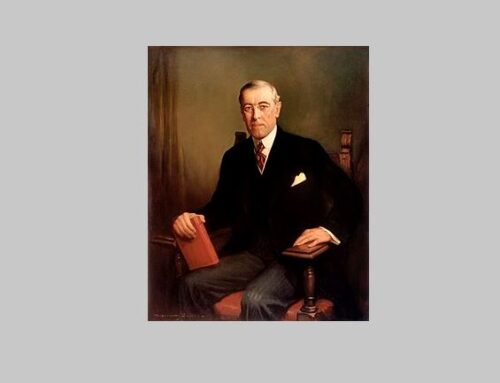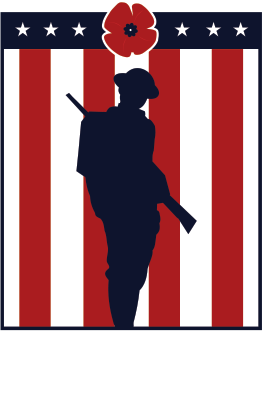Sunday’s ‘Midnight Hammer’ Operation Launched in 1941 to address issues identified in World War I
Published: 26 June 2025
By Stephen Green
via the PJ Media website

WWI Artillery -B-2 Bomber framed
(left) In World War I, SGT James B. Aets uses a quadrant to determine the elevation of U.S. Army 155mm Howitzer, while CPL Charles J. Hines sights on the aiming stake. Circa 1914 to 1918. Photo courtesy the National Archives. (right) B-2 bomber returns to base after participating in Operation Midnight Hammer, 2025. AP Photo/David Smith
The result of serious men using modern technology to correct World War I deficiencies
“On Sunday, when those jets returned to Whiteman, their families were there — flags flying and tears flowing.” —U.S. Air Force Gen. Dan “Razin” Caine, on the B-2 Spirit bomber crews who conducted their part of Operation Midnight Hammer.
The dead-sexy B-2 Spirit bombers and their highly trained crews got all the attention in the days following Operation Midnight Hammer, but there was so much more to the mission than a half-dozen or so stealth jets carrying massive bunker-buster bombs.
How much more? The story begins 15 years ago, when the Pentagon first looked at how to bomb targets like Iran’s Fordow nuclear enrichment facility, buried deep under a mountain. Actually, it began in the 1980s with the development of our first stealth bomber — or no, wait, that’s not quite right either. To tell the full story of Midnight Hammer, I need to take you back to 1941 and a U.S. Army effort to maximize its ability to “reach out and touch someone” with maximum lethality.
Midnight Hammer began simply enough around midnight Eastern on June 21, with a record-setting seven Spirits heading east toward Iran from Whiteman Air Force Base in Missouri. A few other B-2s — the operation now involves more than half of our entire inventory of stealth bombers — fly west toward Guam as decoys. Military analysts on X posted the progress of the decoys, assuming they would land at Diego Garcia in the Indian Ocean, awaiting orders to strike Iran.
Meanwhile, the B-2s making the actual attack fly the first 18-hour leg of their mission unnoticed, despite refueling midair multiple times along the way.
The B-2 is officially rated to carry a payload of 40,000 pounds, but for this mission, each jet carries two 30,000-pound Massive Ordnance Penetrator (MOP) bombs.
As the strike B-2s approach Iran, somewhere (probably) in the Indian Ocean, an Ohio-class guided-missile submarine — believed to be the USS Georgia (SSGN‑729) — launches a volley of 30 Tomahawk land-attack cruise missiles at various targets in Iran.
Things get busy at 17:00 EDT, as the B-2s, Tomahawks, and various jet fighters — taking off from local airbases — all hit Iranian airspace, nearly simultaneously. Nearly 120 fighters — an impressive mix of old-school Air Force and Navy jets, plus stealthy F-22s and F-35s — have several jobs. They’re there to sweep the skies of enemy jets (a threat Tehran never managed to muster), suppress enemy air defenses, perform electronic warfare to blind enemy radars and shut down enemy communications, and stay apprised of targets of opportunity.
Presumably, the Tomahawks are tasked with crippling Iranian airfields and radar.
The B-2s split up into three different flights, targeted at Iran’s various underground processing facilities. Doing the 45,000-feet-in-the-air equivalent of Robin Hood putting a second bullseye’d arrow through the first one, at Fordow, each B-2 drops a second MOP bomb into the shaft created by the first one. Just to be sure.
Blind, deaf, and dumb, Iranian forces sit there, unaware that anything is up before things start going BOOM.
Everybody was on their way home — another 18-hour trip for our B-2 crews — before anybody in Tehran knew that their precious nuclear weapons program had suffered its coup de grace. Just as important, every single one of our pilots and aviators made it home.
Full details of Midnight Hammer might never be known, leaving even big-name outlets like the New York Post without much to do but recycle old reports about how the B-2 crews enjoy amenities like a toilet and a cot.
The concept for the mission, Catherine Herridge reported today, began 15 years ago when a DTRA (Defense Threat Reduction Agency) officer first identified Fordow and “recognized the US did not have a weapon to counter it.” If there’s one thing the Pentagon hates, it’s having a juicy target in a fixed location but not having anything to hit it with.
That’s when a 30,000-pound bomb able to penetrate 200 feet of soil or 60 feet of reinforced concrete was conceived, and I covered the GBU-57 Massive Ordnance Penetrator — and why the B-2 is the only bomber able to carry it — in this column last week.
Originally developed in the 1980s as a Cold War counter to Soviet air defenses in case of a nuclear war, the B-2’s range, payload, and stealthiness have proven invaluable time and time again since entering service in 1997. Even today, the Spirit is still so seemingly invulnerable — at least to second-rate air defenses like Iran’s — that I joked on Right Angle recently that the crew’s biggest worry before departing on their 36-hour mission was, “Did I pack my Kindle?”
That was on Sunday, but we must travel back now to 1941 and the Time on Target (TOT) artillery attacks were developed by the U.S. Army during early World War II training exercises. TOT was invented by serious men looking to use modern technology to correct World War I deficiencies, and generally improve our performance against the bad guys.
→ Read the entire article on the PJ Media website here:
External Web Site Notice: This page contains information directly presented from an external source. The terms and conditions of this page may not be the same as those of this website. Click here to read the full disclaimer notice for external web sites. Thank you.



